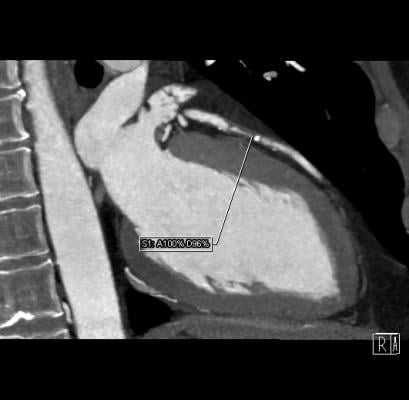March 19, 2015 — Use of computed tomography coronary angiography (CTA), which provides 3-D images of the heart, coupled with standard care allows doctors to more accurately diagnose coronary artery disease in patients presenting with chest pain. This has led to more appropriate follow-up testing and treatments, according to research presented at the American College of Cardiology (ACC) 2015 Annual Scientific Session. Data also showed a trend toward a lower incidence of heart attacks among the group receiving CT scans, compared to usual care.
The data came from the late breaking SCOT-HEART Trial (The Scottish Computed Tomography of the Heart Trial). This is the first major randomized controlled trial to assess clinical outcomes with the implementation of CTA in the management of patients with suspected angina due to coronary heart disease.
Many people presenting with angina — a symptom of coronary artery disease — end up suffering a cardiac event within a couple of years and need timely intervention. At the same time, misdiagnoses of noncardiac chest pain also leave one-third of patients vulnerable to subsequent death from cardiovascular disease, so methods to improve the initial diagnoses and treatments are critical, the authors said.
A total of 4,146 patients at 12 cardiology centers across Scotland who presented to the clinic with chest pain due to suspected coronary artery disease were included in the study. Forty-seven percent were given an initial diagnosis of coronary artery disease using standard protocols and 36 percent were given an initial diagnosis of suspected angina due to coronary artery disease. The remainder were not diagnosed with heart disease and likely had conditions such as indigestion or muscular pain. After this initial visit, all 4,146 patients were then equally randomized to receive standard care — a cardiologist consultation and exercise stress test — alone or in combination with a CT scan. Patients receiving CT scans were much more likely to be given a different diagnosis. All told, 25 percent of these patients were given a different diagnosis after receiving this test compared to just 1 percent of patients who received standard care alone.
The clarification of diagnoses resulted in two significant secondary endpoint measures. Plans for subsequent testing were altered in 15 percent of patients receiving a CT scan compared with just 1 percent of patients in the control group. About 23 percent of patients receiving the CT scan had a change in treatment to correspond with the new diagnosis versus only 5 percent in the control group. There was no difference between the groups in either symptom severity at six weeks or subsequent hospitalizations.
“There have been studies showing that CT coronary angiograms can accurately detect coronary artery disease, but we wanted to move beyond that and ask whether this test is clinically relevant; that is, does it change the patient’s care and outcome?” said David Newby, M.D., Ph.D., British Heart Foundation professor at University of Edinburgh, and chief investigator of the SCOT-HEART trial. “What was very clear from the findings is it can help guide which test to do next, which procedures or drugs to give and ultimately help prevent heart attacks.”
Newby was surprised that after just 20 months of follow-up, there appeared to be a 38 percent reduction in the number of heart attacks in patients who received a CT scan compared with the control group (26 versus 42, respectively), suggesting that clarification of diagnosis and treatment plans may lower the risk of future heart attacks. However, the rate of heart attack in both groups was low and failed to reach statistical significance. Researchers caution that further follow-up data are needed before any definitive conclusions can be drawn regarding the effect of CT scans on cardiovascular outcomes. Still, they said the data suggest that CT scans significantly clarify the diagnosis and lead to more timely focused treatments, which may in turn affect cardiovascular outcomes.
Interestingly, while the use of CT scans appeared to boost the certainty of the diagnosis of angina due to coronary artery disease, the overall frequency of this diagnosis was reduced. Newby explained this occurred because they identified more incorrect diagnoses of angina due to coronary artery disease than previously unrecognized cases of this condition.
“This means we were able to stop unnecessary treatments in the former, which are often given over a lifetime and start new treatments in those now correctly diagnosed with coronary artery disease to prevent future problems; hence the apparent reductions in heart attack,” Newby said.
Coronary artery disease remains the leading cause of death for men and women in the United States. It occurs when plaque builds up in the arteries that supply blood to the heart. Angina is a symptom of coronary artery disease and is often described as squeezing, pressure, heaviness or tightness in the chest. Chest pain due to coronary artery disease affects an estimated 9.1 million people in the U.S. with approximately 500,000 new cases of stable angina each year.
“The message to cardiologists is, if you see a patient in the clinic and you think there is any chance they have coronary artery disease, consider doing a CT scan,” Newby said. “It gives you a very clear answer, and it will help manage the patients.”
The study was funded by Chief Scientist Office in Scotland, with supplementary grant awards from Edinburgh and Lothian’s Health Foundation Trust and the Heart Diseases Research Fund
For more information: acc.org

